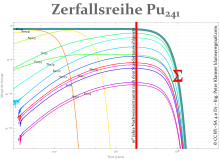Bateman function
In nuclear physics, the Bateman function is the solution for the mathematical model of a radioactive decay series as coupled ordinary differential equations , which describes the quantity and activities in a decay chain as a function of time t.
The parameters are
- the number of isotopes ( ) for which the calculation should be carried out,
- the number of decay products for which the amount N is to be calculated at time t (even ),
- the decay rates ( half-life ) of the individual isotopes i or j in the decay chain,
- the initial amount of isotopes and the amount of isotopes at time t,
- the frequency for a type of decay (e.g. - or - decay, if there are alternative paths in the decay chain).
The model was formulated by Ernest Rutherford in 1905 and the analytical solution was provided by Harry Bateman in 1910.
The Bateman solution for the coupled differential equation for exponential decay processes is also used to describe (bio) chemical or pharmaceutical decomposition processes (also in medicine) quantitatively.
Bateman's role in medicine
The Bateman function is a mathematical relationship that describes a simplified model of the uptake (invasion) or formation and elimination of a substance (usually a drug or an intermediate in a radioactive decay series) as a function of time. The Bateman function is based on the assumption that the substance is distributed in only one compartment and that uptake and elimination follow a first-order reaction . It therefore contains two exponential terms that assume that uptake and elimination only depend on the substance concentration c and thus on the diffusion constant. Active processes for material transport or the different distribution and enrichment z. B. due to the hydrophobicity of the substance are not taken into account. The Bateman function is used to estimate, for example, the point in time and the level of the maximum substance concentration or whether the concentration falls below a minimum. It is named after the British mathematician Harry Bateman (1882–1946). A variant of the Bateman function is:
It denotes the absorption rate, the elimination rate, the dose, the volume of distribution and the bioavailability.
literature
- Harry Bateman : Solution of a System of Differential Equations Occurring in the Theory of Radioactive Transformations . In: Proc. Cambridge Phil. Soc. tape 15 , 1910, pp. 423-427 .
- ER Garrett: The Bateman function revisited: a critical reevaluation of the quantitative expressions to characterize concentrations in the one compartment body model as a function of time with first-order invasion and first-order elimination . In: J Pharmacokinet Biopharm . (1994) 22 (2): pp. 103-128 PMID 7815308
- ER Garrett: Simplified methods for the evaluation of the parameters of the time course of plasma concentration in the one-compartment body model with first-order invasion and first-order drug elimination including methods for ascertaining when such rate constants are equal . In: J Pharmacokinet Biopharm . (1993) 21 (6): pp. 689-734 PMID 8138893
- Bauer, Frömming, Führer: Textbook of Pharmaceutical Technology
- Langguth, Fricker, Wunderli-Allenspach: Biopharmacy
- J. Gabrielsson, D. Weiner: Pharmacokinetic & Pharmacodynamic Data Analysis: Concepts and Applications



![{\ displaystyle \ lambda [i]}](https://wikimedia.org/api/rest_v1/media/math/render/svg/1b908954ed63fd11fadf5a1f74556ab755b42530)



![{\ displaystyle N_ {t} = \ sum _ {i = 1} ^ {decaysteps} N_ {t = 0} [i] \ left (\ prod _ {j = 1} ^ {{decaysteps} -1} {a [j] \ lambda} [j] \ right) \ sum _ {j = 1} ^ {decaysteps} {\ frac {e ^ {t (- {\ lambda} [j])}} {\ prod _ {n = 1} ^ {decaysteps} {If} [n \ neq j, {\ lambda} [n] - {\ lambda} [j], 1]}}}](https://wikimedia.org/api/rest_v1/media/math/render/svg/46cab90171b8cec05c66dec89168030a5f7c78eb)






